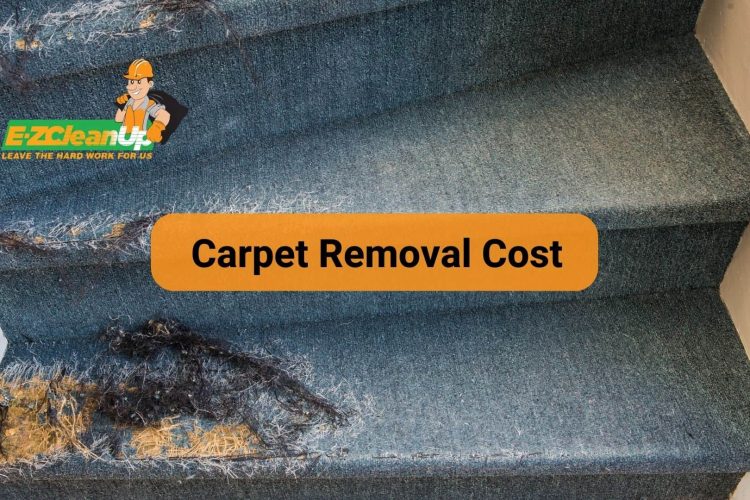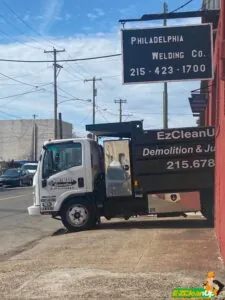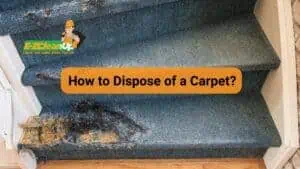Carpet removal costs vary, with professional services ranging from $40 to $125 per hour and disposal fees from $0.45 to $0.60 per square foot. Additional expenses may include furniture moving and subfloor repairs.
Discover more about optimizing your budget by learning about carpet removal costs in our comprehensive guide.
Cost Breakdown of Carpet Removal Services
The cost of labor in carpet removal services can vary widely depending on the job’s complexity and local labor rates. Professional carpet installers typically charge between $40 to $125 per hour. The average rates for a handyman, who can also perform carpet removal, range from $50 to $80 per hour.
These costs can fluctuate significantly based on the location and the specific requirements of the carpet removal job, such as the size of the area, the type of carpet, and any additional difficulties encountered during the removal process.
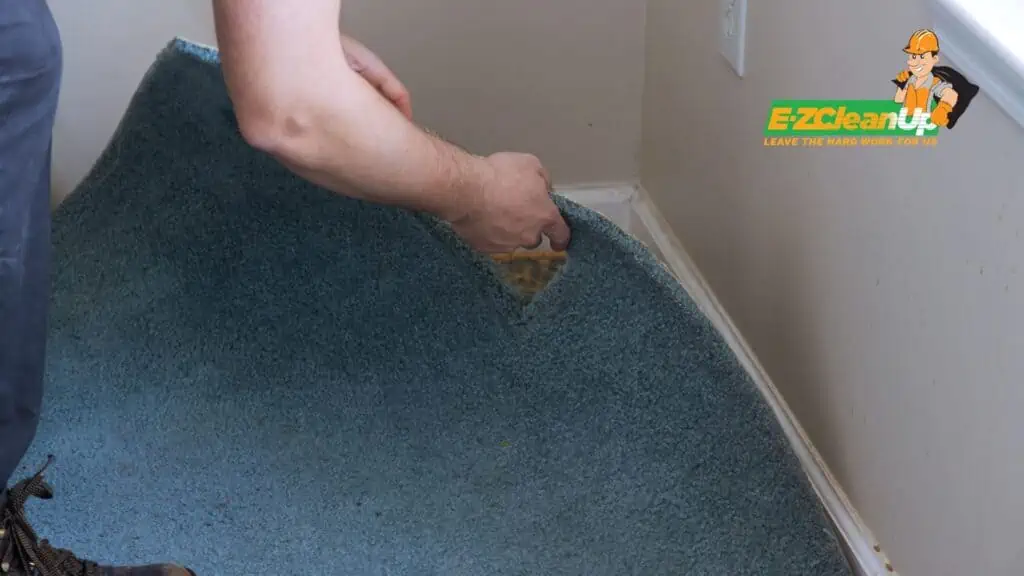
Disposal Fees
Disposal fees are a significant part of the overall cost of carpet removal services. If not included in the contractor’s bid, additional hauling and dump fees can range from $0.45 to $0.60 per square foot on average, depending on the distance to the disposal site.
The average cost for junk removal services, which can be necessary if large quantities of carpet need to be disposed of, ranges from $150 to $350 per load. These fees can vary based on local regulations and the capacity of local waste management facilities. We at EZ CleanUp charge carpet disposal depending on the space it consumes in our truck.
Additional Expenses
Additional expenses in carpet removal can include costs for furniture arrangement, which might require hiring professional movers. This service can cost anywhere from $0.20 to $0.25 per square foot, though some contractors may charge up to $2 per square foot.
Furthermore, if the subfloor needs repairs after carpet removal, this can cost around $500 to $700 for a single room, varying with the room’s size. Additional services like replacing a subfloor or installing floor trim will also add to the overall cost of the project.
These expenses are essential to consider when budgeting for a carpet removal project, as they can significantly impact the final cost.
DIY vs. Professional Carpet Removal: A Cost Comparison
DIY carpet removal can be a viable option for those who are experienced or comfortable with home improvement tasks. While it doesn’t require specialized skills, it is labor-intensive and time-consuming.
The tools required for successful carpet removal include the following:
- Pry bar
- Utility knife
- Pliers
- Vice grips
- Respirator mask
- Safety goggles
- Gloves
- Heavy-duty trash bags
- Claw hammer
- Large vehicle for transporting the carpet
Additional tools such as a scraper, chemical glue remover, and floor sander are necessary if the carpet is glued down. However, completing the job yourself can save on labor costs, though you will still need to consider haulage and disposal fees.
Hiring professionals may be more cost-effective for larger projects involving multiple rooms due to the complexities and volume of work involved.
When to Choose Professional Services
Professional carpet removal is often recommended for safety and efficiency, especially in larger or more complex projects. DIY carpet removal can be difficult and potentially hazardous, particularly when dealing with sharp nails, tack strips, and glue residues. Professional services are equipped with the necessary tools and expertise to handle these challenges and ensure proper carpet disposal.
This is especially important in multi-room projects or commercial settings, where the volume of carpet and logistical complexities can be significant. Professional services mitigate the risks and hassles associated with carpet removal, which makes them a preferable choice for most large-scale or complex carpet removal projects.
Long-term Cost Implications
The long-term cost implications of carpet removal vary depending on the chosen method. DIY carpet removal can initially seem less expensive, but it might result in higher costs if complications arise, such as damage to the subfloor or the need for specialized equipment for glued carpets.
Additionally, the disposal of the old carpet and the installation of new flooring must be considered. When opting for professional services, the higher upfront cost provides the benefit of expertise and efficiency, potentially preventing costly mistakes and ensuring proper disposal.
In both cases, it’s important to consider the overall renovation goals, including the type of new flooring to be installed and any necessary subfloor repairs, as these will significantly impact the total cost of the project. This consideration is crucial when evaluating the long-term financial implications of carpet removal and replacement.
Overview of the Carpet Removal Process
Carpet removal requires a combination of strength, skill, and the right approach. The process typically involves clearing the area of furniture and appliances and cleaning the carpet to reduce the spread of dust and debris. Safety gear like dust masks and gloves is crucial to protect against dust, carpet fibers, and sharp objects like nails and tack strips.
Most carpets are mounted using tack strips, and some might be glued down, which requires careful and methodical cuts to lift the carpet without damaging the subfloor. The actual removal process includes cutting the carpet, especially if you intend to keep it in some areas, removing molding or baseboards, and lifting the carpet from the tack strips.
It’s a process that requires attention to detail, especially if the underlying padding is to be preserved.
Environmental Considerations in Carpet Disposal
Carpet disposal has significant environmental implications. Most discarded carpets containing toxic chemicals from adhesives and stain protectants end up in landfills, which contribute to greenhouse gas emissions. Despite efforts by industry organizations, less than 10% of carpets are recycled.
Initiatives like California’s carpet stewardship program, funded by consumer fees, aim to encourage recycling, but challenges remain, including the economic feasibility of recycling in a market dominated by inexpensive virgin materials. Some manufacturers are adopting sustainable practices, like recycling both their own and competitors’ products and partnering with organizations for reuse.
Despite these efforts, the industry faces problems in achieving higher recycling rates and transitioning to a circular economy. This situation underscores the need for effective take-back programs and policies that support carpet reuse and recycling, as well as consumer awareness about the environmental impact of carpet waste.

Factors Influencing Carpet Removal Cost
Here are the factors that affect the total cost you must allocate for carpet removal:
Size and Type of Carpet
The cost of carpet removal varies based on the room’s size and the carpet type. Specific types of carpets, like wall-to-wall carpet and pad, glued carpet with padding underneath, basement carpet, and stair carpet, have different removal costs. Thicker carpets made from heavy materials like wool are more expensive to remove compared to thinner ones.
The size of the room also plays a critical role, with larger rooms requiring more labor, thus increasing costs. Asymmetrical rooms with unique shapes may incur higher removal costs due to the added complexity and labor involved.
Complexity of Removal Process
The removal process’s complexity significantly impacts the total cost. Factors contributing to complexity include the carpet’s installation method and the need for prep work like moving furniture and removing doors.
For instance, carpets installed by “tack-less” stretch-in installation are easier to remove, while stapled-down or glued-down carpets are more challenging and expensive to take out. Additional elements like the need for carpet disposal, which may include hauling and dump fees, and potential flooring repairs can also influence the cost.
Wet carpets, which are heavier and may contain mold, are more costly to remove. Removal of carpet padding and tack strips, if required, can further elevate the price.
Geographic Location and Market Rates
Different municipalities have varying waste disposal fees, which can change across state lines. The local disposal center’s charges can also vary based on whether you live in a densely populated urban area or a more sparsely populated rural area.
In addition to disposal fees, labor rates differ by location, with some contractors charging separate labor fees on top of their hourly rates. The cost of recycling the removed carpet can also vary by location. Some areas may have recycling centers that accept carpets, while others may not, which affects the overall cost of carpet removal and disposal.
Selecting the Right Carpet Removal Service
When choosing a carpet removal service, focus on the services they offer, disposal methods, and charging structure. It’s key to find a provider that understands the proper disposal of old carpeting, as many waste centers reject large carpet volumes.
Start by confirming the service area and scheduling options of providers, as some may not serve your region or might require specific booking methods.
Also, differentiate between removal and disposal services; the former involves physically taking out the carpet, while the latter deals with disposing of it after removal. Cost can vary, and sometimes, additional fees apply, so be vigilant about the pricing structure.
Understanding Service Guarantees and Warranties
Carpet warranties from manufacturers cover performance expectations for a set period, often addressing defects in material or workmanship. These warranties can vary greatly, cover different types of damage, and offer different durations. It’s important to understand both the coverage and limitations, as some may not cover normal wear and tear or damage from pets.
Familiarize yourself with the fine print, including any conditions that might void the warranty. Also, consider the installation aspect, as improper installation can void warranties. Knowing how to care for and maintain your carpet is crucial to ensure warranty coverage. If a claim arises, be prepared with documentation and follow the manufacturer’s claim process.
Eco-friendly Carpet Disposal Options
Here are the most environment-friendly ways to dispose of your old carpet:
Recycling Carpets
Most types of carpets are recyclable, including the padding. During the recycling process, carpets are broken down into their raw components, which can then be reused to manufacture new products such as car interiors, industrial flooring, composite lumber, and more.
To recycle old carpets, you can reach out to organizations like Carpet America Recovery Effort (CARE), local waste management companies, or carpet dealers. Some carpet manufacturers also offer recycling programs for their products, which allows for environmentally responsible disposal of old carpets.
Upcycling and Reuse Possibilities
Upcycling is an eco-friendly option for old carpets that are still in good condition. Creative upcycling ideas include sewing carpet scraps into decorative area rugs, using pieces for garden kneeling pads, making cat scratching posts, using them as sound mufflers under appliances, or creating DIY car floor mats.
In addition, old carpets can be used to line pet crates or placed under vehicles in garages to absorb drips. Upcycling not only extends the life of the carpet but also prevents it from ending up in landfills.
Environmentally Responsible Disposal Practices
For carpets that cannot be recycled or upcycled, environmentally responsible disposal practices are essential. Shredded carpets can serve as an alternative to traditional mulching in gardens, offering different nutrients to the soil.
Old foam padding from carpets can be reused as underlayment in home renovations or donated as an eco-friendly material for educational purposes. When disposing of carpets, it’s important to avoid illegal dumping and to consider the environmental impact.
Utilizing carpet reclamation centers, which specialize in carpet recycling, ensures that the carpet is processed efficiently and responsibly.
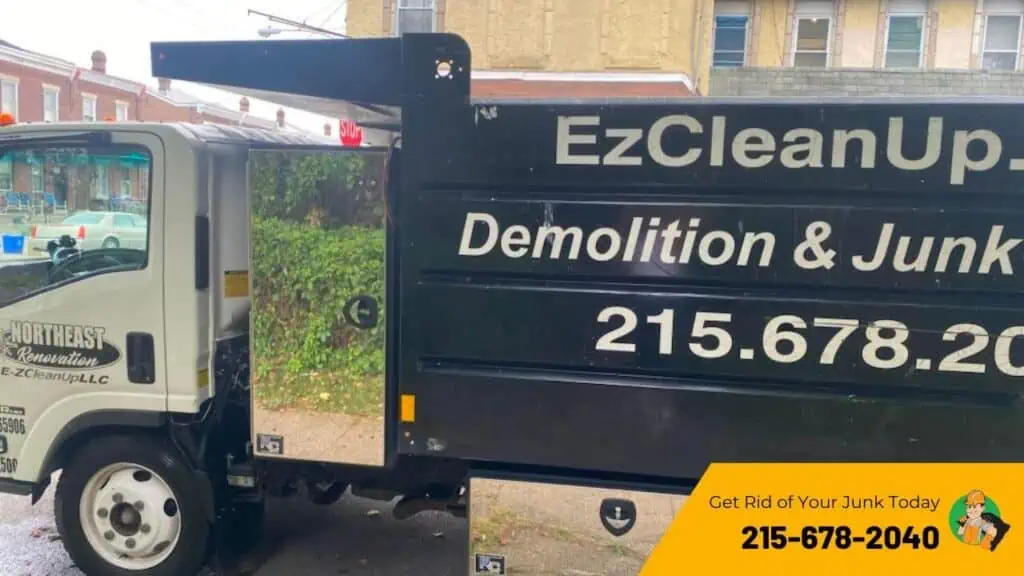
Efficient Carpet Removal and Disposal with EZ CleanUp
Thinking about carpet removal costs can be intimidating, especially when the budget is tight, but EZ CleanUp makes the process straightforward and cost-effective. As a local business based in Philadelphia, we extend our services to the surrounding areas while ensuring quick and eco-friendly junk removal solutions.
Whether you’re undertaking a significant clearing project, including garage cleanout, removing a mattress, or simply discarding old carpets, we’re your go-to team. Our transparent and budget-friendly pricing reflects our commitment to affordability without sacrificing quality. Plus, our eco-conscious approach means we recycle and donate whenever possible, aligning with our goal to positively impact the environment.
With EZ CleanUp, you experience prompt, professional service tailored to your schedule, even offering same-day options for urgent needs. Choose EZ CleanUp for an efficient, environmentally responsible solution to your carpet removal and disposal and junk clearing needs. Call us today to get a free quote.

